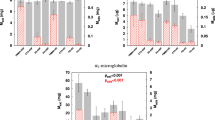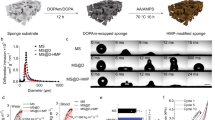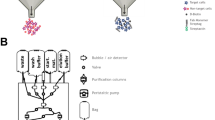Abstract
The presence of adventitious viruses in blood products for transfusion poses serious risks. Using cell surface receptors as affinity ligands, we have developed a novel approach to remove both free virions and virus-infected cells with minimal protein loss. The affinity adsorbent was prepared by immobilizing cells or cell membranes that bear the complementary receptors for the target viruses on inert polymer support surfaces, followed by chemically cross-linking the cells with glutaraldehyde. The stabilization process did not impede the adsorption process as measured in herpes simplex virus and human cytomegalovirus systems. Cellular adsorbents prepared in this manner have the advantages of high binding specificity, broad adsorption spectrum, and ease of preparation.
This is a preview of subscription content, access via your institution
Access options
Subscribe to this journal
Receive 12 print issues and online access
$209.00 per year
only $17.42 per issue
Buy this article
- Purchase on Springer Link
- Instant access to full article PDF
Prices may be subject to local taxes which are calculated during checkout
Similar content being viewed by others
References
Gellis, S.S., Neefe, J.R., Stokes, J., Strong, L.E., Janeway, C.A. and Scatchard, G. 1948. Chemical, clinical and immunological studies on the viruse of homologous serum hepatitis in solutions of normal human serum albumin by means of heat. J. Clin. Invest. 27:239–244.
Schwinn, H., Heimburger, N., Kumpe, G. and Herchenhan, B. 1981. Blood coagulation factors and process for their manufacture. U.S. Patent 4,297,344.
Fernandes, P. and Lundblad, J.L. 1948. Pasteurized therapeutically active protein composition. U.S. Patent 4,440,679.
Ng, P.K. and Dobkin, M.B. 1985. Pasteurization of antihemophilic factor and model virus inactivation studies. Thromb. Res. 39:439–447.
Prince, A.M., Stephan, W.S. and Brotman, B. 1983. Beta-propiolac-tone/ultraviolet irradiation: a review of its effectiveness for inactivation of viruses in blood derivatives. Rev. Infect. Dis. 5:92–107.
Mitra, G. and Wong, M. 1986. Use of lipid solvents for viral inactivation in factor VIII concentrates. Biotech. Bioeng. 28:297–300.
Einarsson, M. and Flehmig, B.J. 1984. Adsorption properties of different hepatitis B virus related antigens on octanohydrazide-sepharose 4B. Virol. Met. 8:233–241.
Charm, S.E. and Wong, B.L. 1974. An immunoadsorbent process for removing hepatitis antigen from blood and plasma. Biotech. Bioeng. 59:593–607.
Marcinick, R.A., Wands, J.R., Bruns, R.R., Malchesky, P.S., Nose, Y. and Haber, E. 1983. Quantitative removal of hepatitis B viral antigens from serum by a monoclonal IgM coupled to a biocompatible solid-phase support. Proc. Natl. Acad. Sci. USA 80:3821–3825.
Lonberg-Holm, K. 1981. Attachment of animal viruses to cells: an introduction, p. 1–20. In: Virus Receptors Part 2 (Lonberg-Holm K. and Philipson, L., eds.). Chapman and Hall, New York.
Tardieu, M., Epstein, R.L. and Weiner, H.L. 1982. Interaction of viruses with cell surface receptors. Internatl. Rev. Cytol. 80:27–61.
Dimmock, N.J. 1982. Initial Stages in infection with animal viruses. J. Gen. Virol. 59:1–22.
Ziegler, R.J. and Pozos, R.S. 1981. Effects of lectins on peripheral infection by herpes simplex virus of rat sensory neurons in culture. Infect. Immun. 34:588–595.
Bradford, M. 1976. A rapid and sensitive method for the quantitation of microgram quantities of protein utilizing the principle of protein-dye binding. Anal. Biochem. 72:248–254.
Vahlne, A., Svennerholm, B. and Lycke, E.J. 1979. Evidence for herpes simplex virus type-selective receptors on cellular plasma membrane. Gen. Virol. 44:217–225.
Huggins, J.W., Jahrling, P.B., Rill, W. and Linden, C.D. 1982. Characterization of the binding of the TC-83 strain of Venezuelan equine encephalomyelitis virus to BW-J-M, a mouse macrophage-like cell line. J. Gen. Virol. 64:149–157.
Co, M.S., Gaulton, G.N., Fields, B.N. and Greene, M.I. 1984. Isolation and biochemical characterization of the mammalian reovirus type 3 cell surface receptor. Proc. Natl. Acad. Sci. USA 82:1494–1498.
Tsao, I-F., Wang, H.Y. and Shipman, C., Jr. 1988. Antiviral activity of a surface-bonded quaternary ammonium chloride. submitted to Biotechnol. Bioeng.
Author information
Authors and Affiliations
Rights and permissions
About this article
Cite this article
Tsao, IF., Shipman, C. & Wang, H. The Removal of Adventitious Viruses and Virus-Infected Cells Using a Cellular Adsorbent: A Feasibility Study. Nat Biotechnol 6, 1330–1333 (1988). https://doi.org/10.1038/nbt1188-1330
Received:
Accepted:
Issue Date:
DOI: https://doi.org/10.1038/nbt1188-1330



